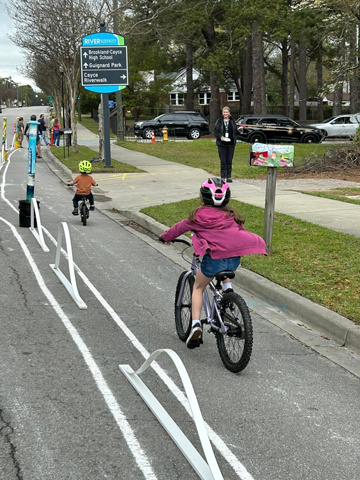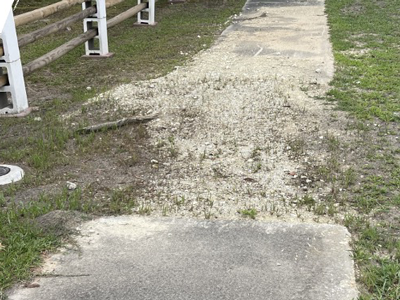By Adrienne Patrick

Last summer, Wholespire, with support, guidance, and funding from the South Carolina Department of Public Health (formerly the SC Department of Health and Environmental Control) introduced the Walkability Action Institute/Walkability Virtual Academy (WAI/WVA) to local teams from around the state in efforts to help create more walkable and movable communities. In partnership with the National Association of Chronic Disease Directors and the Centers for Disease Control and Prevention, WAI brought in national experts to present how best to design walkable communities for people of all ages and abilities in areas where they live, learn, work, and play.
The notion of creating more walkable communities may seem like a daunting task, particularly for rural towns that struggle to find the time and resources to devote to such projects. However, WAI helped remind its participants that small efforts can lead to bigger changes. Community walkability projects, even on a minor scale, can impact not only citizens’ health and safety but local economic opportunities as well.
But where do you even begin? To start with, community engagement is critical. Assessing community readiness and educating citizens before any changes are made are important first steps.
“Community buy-in is important. Without their understanding, all of this is for naught. We’re using varying approaches to educate since people care about different things – beautification, pedestrian and public safety, jobs and small business, less traffic, increased real estate values, and social connection,” said Dara Brown, Chair of the Active & Accessible Community Transit Coalition and a member of the Cayce-West Columbia WAI team.
While there is a long-term goal of creating an inclusive, inter-municipal walk + bike loop in the Cayce – West Columbia arts district to promote tourism and connect lower-income areas to everyday destinations, conducting pop-up demonstrations and walk audits for this project helped identify solutions for immediate needs. Bike racks for both cities were installed, and a four-way stop sign was added in an underserved community to slow vehicular traffic. Other neighborhoods noticed and began asking for stop signs near parks and where school buses pick up children.
The more prepared and involved the community is, the easier it becomes to approach local councils and government officials with needed projects. “Training is about conversations. Engaging community leaders and informing them on how walkability can improve other issues such as safety and crime is critical,” said Dara.
The idea that place affects health – how a community’s built environment contributes to eating healthy and being physically active in a safe manner – was another resounding theme at WAI. With cars as the primary mode of transportation, sidewalks are not as commonplace in rural communities since fewer people and destinations tend to be more spread apart. The sidewalks that do exist are less likely to receive maintenance.

The Town of Lane is part of Williamsburg County, another local team of public health, planning, and transportation representatives that participated in WAI. Delores Cantey, a resident of Lane, has an adult paraplegic son and has fought for safer road infrastructure for decades. With no real sidewalk network, she says his only option to get around town in his wheelchair includes the side of a highway.
“He’s entitled to have a good quality of life outside of his home. I think Council and local government are starting to see how everyone wants sidewalks as a safe option for travel,” she said.
Since WAI, the Town of Lane identified a need for traffic-reducing devices in areas of high use by people with disabilities, seniors, and youth. A radar speed sign and flasher kits were installed to warn drivers that they are entering a pedestrian crossing and to reduce speed.
“WAI was the catalyst for helping develop a connection to why we should consider these types of walkability projects. It served as an eye-opener of what could be done in a small town and rural community. It’s a real issue, and now we can do something about it,” said Regina Smith-Dimery, Community Engagement Manager for the South Carolina Department of Public Health and a member of the Williamsburg County WAI team.
So, what are some practical steps to implement walkability projects in your area?
- Create an advisory committee made up of a diverse group of citizens to help increase public awareness and education about walkability and to identify projects that address specific community needs. Invite local leadership to participate.
- Conduct assessments, which are free or low-cost, to help determine how pedestrian and bike-friendly a community is as well as what citizens view as priorities. These can include walk audits, “windshield tours,” and surveys. Try to plan these activities alongside existing community events where there will already be a crowd.
- Put together a list of potential projects and then prioritize them based on importance, how capable the community is to implement and timely complete the project, and the feasibility of having the funding.
- Phasing larger projects helps make tasks more manageable. Rather than a 10-mile sidewalk, prioritize key intersections to start with.
- Continue momentum in the community by holding pop-ups and town hall meetings and creating appealing message development. Maintain intentional communication of what the goals are and how partners can fit in to increase participation.
Walkability and active transportation planning is a public health focus area that has the potential to have a positive community and statewide impact on our health, environment, and economy. Active community environments, where people of all ages and abilities have opportunities to be physically active for both recreation and transportation, must be thoughtfully designed with a holistic approach. The Walkability Action Institute proved even small steps towards this overarching goal can make a notable difference.
Wholespire remains committed to providing technical assistance and training to promote walkable, active and connected communities.

